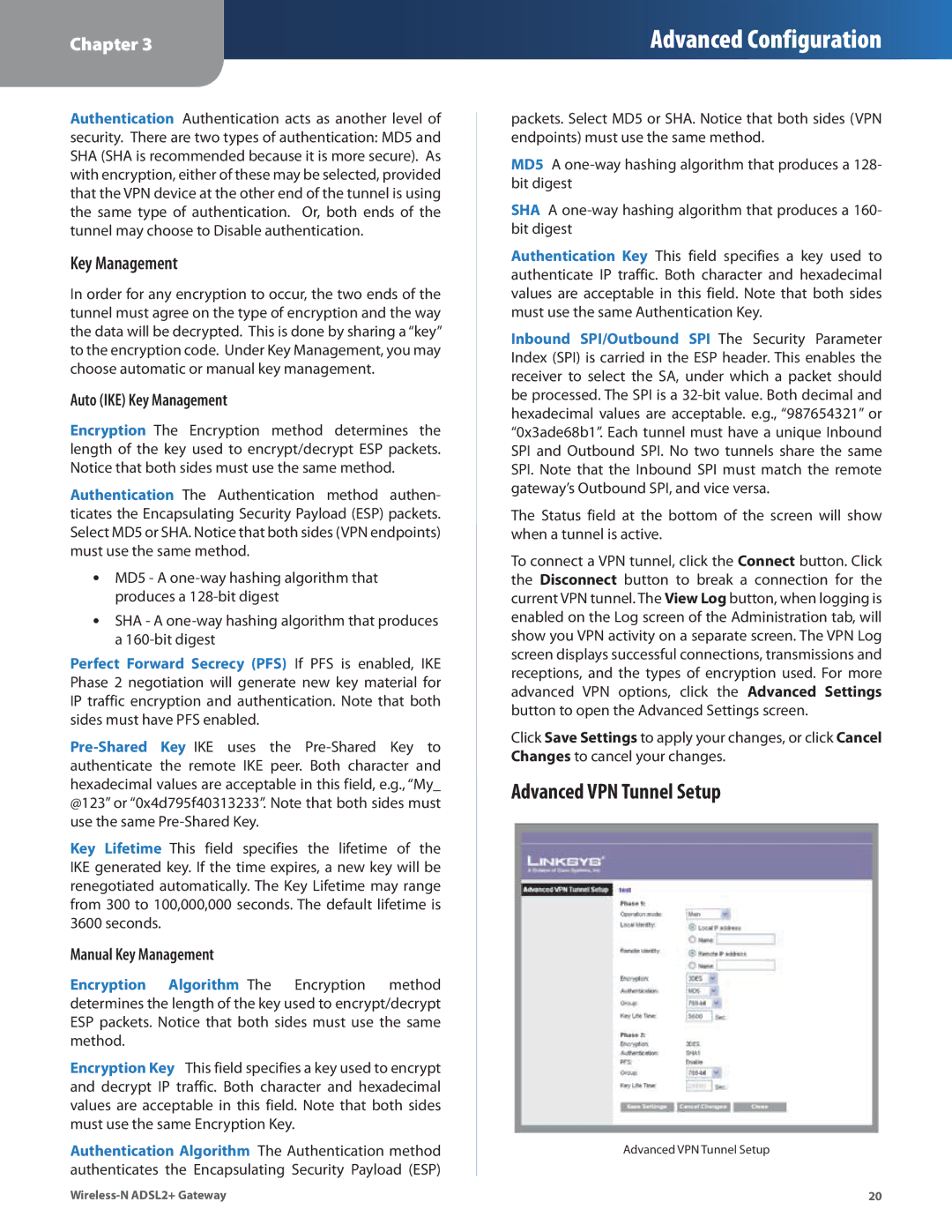
Chapter 3
Advanced Configuration
Authentication Authentication acts as another level of security. There are two types of authentication: MD5 and SHA (SHA is recommended because it is more secure). As with encryption, either of these may be selected, provided that the VPN device at the other end of the tunnel is using the same type of authentication. Or, both ends of the tunnel may choose to Disable authentication.
Key Management
In order for any encryption to occur, the two ends of the tunnel must agree on the type of encryption and the way the data will be decrypted. This is done by sharing a “key” to the encryption code. Under Key Management, you may choose automatic or manual key management.
Auto (IKE) Key Management
Encryption The Encryption method determines the length of the key used to encrypt/decrypt ESP packets. Notice that both sides must use the same method.
Authentication The Authentication method authen- ticates the Encapsulating Security Payload (ESP) packets. Select MD5 or SHA. Notice that both sides (VPN endpoints) must use the same method.
•MD5 - A
•SHA - A
Perfect Forward Secrecy (PFS) If PFS is enabled, IKE Phase 2 negotiation will generate new key material for IP traffic encryption and authentication. Note that both sides must have PFS enabled.
Key Lifetime This field specifies the lifetime of the IKE generated key. If the time expires, a new key will be renegotiated automatically. The Key Lifetime may range from 300 to 100,000,000 seconds. The default lifetime is 3600 seconds.
Manual Key Management
Encryption Algorithm The Encryption method determines the length of the key used to encrypt/decrypt ESP packets. Notice that both sides must use the same method.
Encryption Key This field specifies a key used to encrypt and decrypt IP traffic. Both character and hexadecimal values are acceptable in this field. Note that both sides must use the same Encryption Key.
Authentication Algorithm The Authentication method authenticates the Encapsulating Security Payload (ESP)
packets. Select MD5 or SHA. Notice that both sides (VPN endpoints) must use the same method.
MD5 A
SHA A
Authentication Key This field specifies a key used to authenticate IP traffic. Both character and hexadecimal values are acceptable in this field. Note that both sides must use the same Authentication Key.
Inbound SPI/Outbound SPI The Security Parameter Index (SPI) is carried in the ESP header. This enables the receiver to select the SA, under which a packet should be processed. The SPI is a
The Status field at the bottom of the screen will show when a tunnel is active.
To connect a VPN tunnel, click the Connect button. Click the Disconnect button to break a connection for the current VPN tunnel. The View Log button, when logging is enabled on the Log screen of the Administration tab, will show you VPN activity on a separate screen. The VPN Log screen displays successful connections, transmissions and receptions, and the types of encryption used. For more advanced VPN options, click the Advanced Settings button to open the Advanced Settings screen.
Click Save Settings to apply your changes, or click Cancel Changes to cancel your changes.
Advanced VPN Tunnel Setup
Advanced VPN Tunnel Setup
20 |
